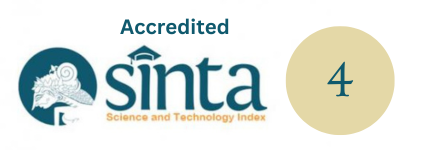Introduction to the Musical Composition “Telung Benang” | Pengantar Komposisi Karawitan “Telung Benang”
DOI:
https://doi.org/10.59997/jurnalsenikarawitan.v2i2.440Keywords:
Rwa Bhineda, Gender Wayang, Semaradhana, KarawitanAbstract
Telung Benang's musical artwork is inspired by the concept of rwa bhineda. Rwa bhineda is the balance of human life in a dualistic dimension, namely believing in the existence of two very powerful forces. This duality dimension concerns the difference between high-low, black-and-white, narrow-broad, and so on. The purpose of the creation of Telung Benang's artwork is to highlight two contradictory but interrelated characters (duality) into the musical language with the title of Telung Benang's work. Telung Benang is a term for numbers in Balinese which means seventy-five (75). Telung Benang is used as a title that will be realized with the concept that has been made, namely the pelog tone (7) and the slendro tone (5) combined to produce different colors and sound harmonies. The method of creating Telung Benang's works is arranged through three stages of creation, namely exploration, improvisation, and formation. Structurally, Telung Benang's work is divided into two parts. The division is done because it is based on the concept of duality which aims to highlight two parts that have different characteristics or colors (contrast) in one piece of music. This is what is meant as a typical reflection of the concept of dualism.
Downloads
References
Abdul Sjukur, S. (2012). Virus Setan Risalah Pemikiran Musik. Art Music Today.
Ardana, I. K. (2012). Sekala Niskala: Realitas Kehidupan Dalam Dimensi Rwa Bhineda. Dewa Ruci: Jurnal Pengkajian Dan Penciptaan Seni, 8(1), 139–156. https://doi.org/10.33153/dewaruci.v8i1.1097
Ardana, I. K. (2013). Pengaruh Gamelan terhadap Baleganjur Semaradana. Resital, 14(2), 141–152.
Bandem, I. M. (1986). Prakempa, Sebuah Lontar Gamelan Bali (Trans.). ASTI Denpasar.
Bandem, I. M. (2013). Gamelan Bali di atas Panggung Sejarah. Badan Penerbit STIKOM Bali.
Bhumi, I. M. B. P. H. S. (2019). Pelatihan Gender Wayang Pada Generasi Muda Bali Untuk Melawan Dampak Negatif Kemajuan Teknologi. KALANGWAN Jurnal Seni Pertunjukan, 5(2), 99–105. https://jurnal.isi-dps.ac.id/index.php/kalangwan/article/view/777
Dibia, I. W. (2017). Kotekan Dalam Musik Dan Kehidupan Bali. Bali Mangsi Foundation dan ISI Denpasar.
Hardjana, S. (2003). Corat Coret Musik Kontemporer Dulu dan Kini. Ford Foundation.
Hawkins, A. M. (2003). Mencipta Lewat Tari (Y. S. Hadi (ed.)). Manthili.
Kariasa, I. N., & Putra, I. W. D. (2021). Karya Karawitan Baru Manikam Nusantara. Mudra Jurnal Seni Budaya, 36(2), 222–229. https://doi.org/10.31091/mudra.v36i2.1471
S., I. W. R. (2001). Gong Antologi Pemikiran. Balimangsi Foundation, Institut Seni Indonesia Denpasar.
Santosa, H. N. H. K. R. M. (2017). Seni Pertunjukan Bali Pada Masa Dinasti Warmadewa. MUDRA Jurnal Seni Budaya, 32(1), 81–91. https://jurnal.isi-dps.ac.id/index.php/mudra/article/view/84
Sugiartha, I. G. A. (2012). Kreativitas Musik Bali Garapan Baru Perspektif Cultural Studies. Institut Seni Indonesia Denpasar.
Suwitra Pradnya, I. B. (2017). Purusha dan Predhana Dalam Agama Hindu dan Hukum Adat Bali. Pustaka Ekspresi.
Wijayanto, A. N., & Sumerjana, K. (2015). Bunyi Ngumbang Ngisep Gender Wayang Bali dalam Kajian Semiotika. MUDRA JURNAL SENI BUDAYA, 30(1), 1–7.
Yudana, I. G., & Haryanto, T. (2021). Contemporary Music Composition “Embryo”| Komposisi Musik Kontemporer “Embrio.” GHURNITA: Jurnal Seni Karawitan, 1(1), 1–10. https://jurnal2.isi-dps.ac.id/index.php/ghurnita/article/view/147








